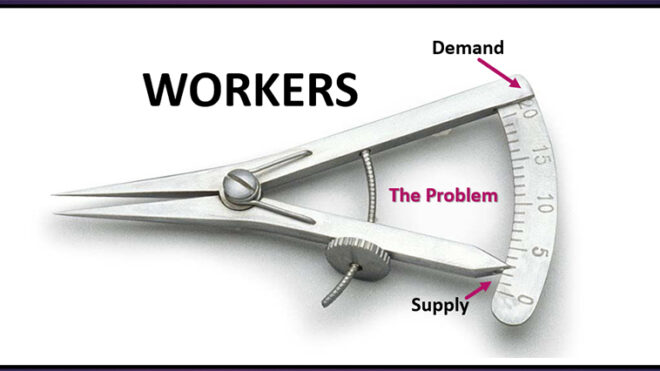The gap between labor supply and demand continues to vex US employers, even as talk of recession and high profile layoffs pepper the news. And yet as we move into the autumn of 2022, the glaring fact is that there are still many (as in millions) more jobs to be filled than there are people willing, able, and available to fill them. Companies have plenty of demand for their products and services, but an insufficient supply of labor to support that demand. And that costs money.
So the question endures: Where did all the workers go?
On July 27 and September 12 of this year, this blog took a stab at identifying three reasons behind the drop in labor participation. Here are three more:
Answer #4: Fewer workers from outside the US. This statement isn’t political. It’s numerical.
US Immigration policy changed in 2016, and as a result, there’s been a steady drop in the number of immigrants entering the country since that year. This reduction was exacerbated by the COVID pandemic. Whatever the cause, there were roughly 350,000 fewer new immigrants in 2021 than in 2019, extending a steady decline in that segment of the labor supply over the last six years. In order to understand the labor shortage, it doesn’t matter whether or not those immigrants are qualified, or even here legally. What matters is that there are fewer joining the workforce each year.
This is not the biggest contributor to the problem, but it’s in the mix. It all adds up.
Answer #5: Lots of people with jobs have had COVID and were sidelined for a week or two. And after they recovered, another bunch fell ill, continuing the cycle.
Remember this past summer, when so many flights were canceled? And you couldn’t get seated in a restaurant that obviously had plenty of empty tables? Uber/Lyft wait times shot up. So did grocery delivery times. Those were just the most visible effects of the worker shortage. Oh, these people had jobs; they just couldn’t report to work. The same thing happened in factories and offices all over the country.
This problem has abated in recent months, but at several surge points after the initial crisis, even as the disease became less deadly, it’s estimated that as many as 5 million employed people in the US weren’t working on any given day, because of the virus. Either they had it, or they were living with someone who did. That’ll put a huge dent in productivity, even if your payroll appears to be fully staffed.
Two important points here: 1) future surges are highly likely, so smart employers are preparing for the inevitable absences, and 2) this makes a strong argument for a hybrid/remote workplace setup for knowledge workers. When that’s an option, those with mild or absent symptoms, and those who test negative, but are living with someone with COVID, may choose to work, and that’ll help.
Answer #6: A lot of people are quitting their jobs – an average of more than 4 million in the US every month of this year. The vast majority are moving to a new job, but there’s an average gap of about a week and a half between jobs. And let me remind you, that’s 4 million people on a rolling cycle. Plus, we’ve long known that the least productive periods of an employee’s tenure are the last few – and first few weeks of the job. Another huge productivity drain.
Think about it this way. The flight time for a direct flight from my home airport in Jacksonville, Florida, to Nashville, Tennessee, is 100 minutes. A set of straight line connecting flights between the same two points, but with a stop in Atlanta, takes 136 minutes, not counting the connection time in the airport. The extra 36% is due entirely to getting up to speed and slowing down, not once, but twice on the same journey.
Keeping the people you’ve got, through effective leadership and an attractive culture will get you closer to meeting your customers’ demands and maximizing the revenue they bring you.
The point: As was said in the earlier two posts, no single reason, on its own, can explain the huge deficit in available workers. But all together, they make perfect sense.
Stay tuned for one last installment of “Where Did All the Workers Go” in the next week or two (subscribe to be notified). And if you want to learn how to compete – and win – for this limited supply of available talent, I can come to your organization or professional association meeting, with the message “Recruiting, Onboarding, and Retention in the New World of Work“.
Where Did All the Workers Go?
book richard or bill to speak for your meeting


